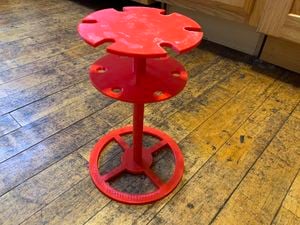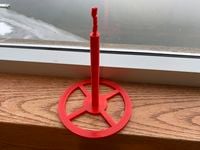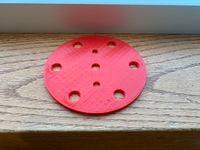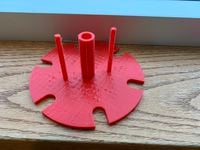Pipette Carousel OSAT Project
Project developed by Sam Wurst
Template:Statusboxtop Template:Status-design Template:Status-prototype You can help Appropedia by contributing to the next step in this OSAT's status. Template:Boxbottom
Abstract
This Open Source Appropriate Technology (OSAT) fulfills a request for pipette accessories on the "Requests for 3-D printable open source appropriate technology" Appropedia page. I chose this OSAT because sanitation in any type of healthcare situation is vital to avoid infections and disease. This carousel keeps medical and lab pipettes suspended so as not to contaminate both the area around the and the samples inside them clean and safe.
Picture of completed pipette carousel print using my printer 
Bill of Materials
- Pipette Carousel Base - 44g PLA 3D printer filament
- Pipette Carousel Lower Layer - 24g PLA 3D printer filament
- Pipette Carousel Upper Layer - 36g PLA 3D printer filament
Unable to upload FreeCAD and stl files to Appropedia. Files can be found by selecting the following Thingiverse link: https://www.thingiverse.com/thing:4023762.
Tools needed for fabrication of the OSAT
MOST Delta RepRap or similar RepRap 3-D printer
Skills and Knowledge Necessary to Make the OSAT
I need experience using a 3D printer, CAD software (FreeCAD), and 3D object slicing software (Cura).
Technical Specifications and Assembly Instructions
Print all pieces at 15% infill. Adhere to print surface by applying a glue stick to the surface shortly before starting the print.
Estimated print time: 2 hours 42 minutes.
Estimated print time: 1 hours 23 minutes.
Estimated print time: 2 hours 10 minutes.
Assembly time: 1 minute
Common Problems and Solutions
The pieces need to be adhered to the print surface, otherwise they tend to curl up. This project is a simple print and put together.
Cost savings
- If your solution is not a low cost one then it is not really appropriate.
- Estimate your costs
- Find a commercial equivalent, cite it and put the [url in square brackets]
- Calculate $ savings and % savings
Benefited Internet Communities
- Name and add links to at least 5 using single brackets around [url name]
References
- The sources of information (e.g. engineering handbooks, journal articles, government documents, webpages, books, magazine articles etc.). References should use the <ref> </ref> and <references/> tags and can be in any format but should include all the information necessary for someone else to find the same information you did. For example: [1]
- ↑ web page: Department of Energy (DOE) Landscaping and Energy Efficiency, DOE/GO-10095 (1995) Available: http://www.eren.doe.gov/erec/factsheets/landscape.html
Based on the developmental needs addressed (e.g. food, heat, electricity, clean water, health care, etc.) be sure to label your device in the proper categories e.g. use [[Category:Water]]. Be sure to categorize your device so that it will be easy to find – for example “Low voltage connection basics” is categorized in [[Category:How tos]] [[Category:Electricity]] [[Category:Electric lighting]].


